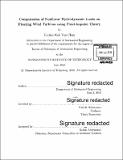| dc.contributor.advisor | Paul D. Sclavounos. | en_US |
| dc.contributor.author | Chan, Godine Kok Yan | en_US |
| dc.contributor.other | Massachusetts Institute of Technology. Department of Mechanical Engineering. | en_US |
| dc.date.accessioned | 2016-09-13T19:17:49Z | |
| dc.date.available | 2016-09-13T19:17:49Z | |
| dc.date.copyright | 2016 | en_US |
| dc.date.issued | 2016 | en_US |
| dc.identifier.uri | http://hdl.handle.net/1721.1/104254 | |
| dc.description | Thesis: Ph. D., Massachusetts Institute of Technology, Department of Mechanical Engineering, 2016. | en_US |
| dc.description | Cataloged from PDF version of thesis. | en_US |
| dc.description | Includes bibliographical references (pages 199-202). | en_US |
| dc.description.abstract | Wind energy is one of the more viable sources of renewable energy and offshore wind turbines represent a promising technology for the cost effective harvesting of this abundant source of energy. To capture wind energy offshore, horizontal-axis wind turbines can be installed on offshore platforms and the study of hydrodynamic loads on these offshore platforms becomes a critical issue for the design of offshore wind turbine systems. A versatile and efficient hydrodynamics module was developed to evaluate the linear and nonlinear loads on floating wind turbines using a new fluid-impulse formulation - the Fluid Impulse Theory(FIT). The new formulation allows linear and nonlinear loads on floating bodies to be computed in the time domain, and avoids the computationally intensive evaluation of temporal and spatial gradients of the velocity potential in the Bernoulli equation and the discretization of the nonlinear free surface. The module computes linear and nonlinear loads - including hydrostatic, Froude-Krylov, radiation and diffraction, as well as nonlinear effects known to cause ringing, springing and slow-drift loads - directly in the time domain and a stochastic seastate. The accurate evaluation of nonlinear loads by FIT provides an excellent alternative to existing methods for the safe and cost-effective design of offshore floating wind turbines. The time-domain Green function is used to solve the linear and nonlinear free-surface problems and efficient methods are derived for its computation. The body instantaneous wetted surface is approximated by a panel mesh and the discretization of the free surface is circumvented by using the Green function. The evaluation of the nonlinear loads is based on explicit expressions derived by the fluid-impulse theory, which can be computed efficiently. | en_US |
| dc.description.statementofresponsibility | by Godine Kok Yan Chan. | en_US |
| dc.format.extent | 202 pages | en_US |
| dc.language.iso | eng | en_US |
| dc.publisher | Massachusetts Institute of Technology | en_US |
| dc.rights | M.I.T. theses are protected by copyright. They may be viewed from this source for any purpose, but reproduction or distribution in any format is prohibited without written permission. See provided URL for inquiries about permission. | en_US |
| dc.rights.uri | http://dspace.mit.edu/handle/1721.1/7582 | en_US |
| dc.subject | Mechanical Engineering. | en_US |
| dc.title | Computation of nonlinear hydrodynamic loads on floating wind turbines using fluid-impulse theory | en_US |
| dc.type | Thesis | en_US |
| dc.description.degree | Ph. D. | en_US |
| dc.contributor.department | Massachusetts Institute of Technology. Department of Mechanical Engineering | |
| dc.identifier.oclc | 958145054 | en_US |
